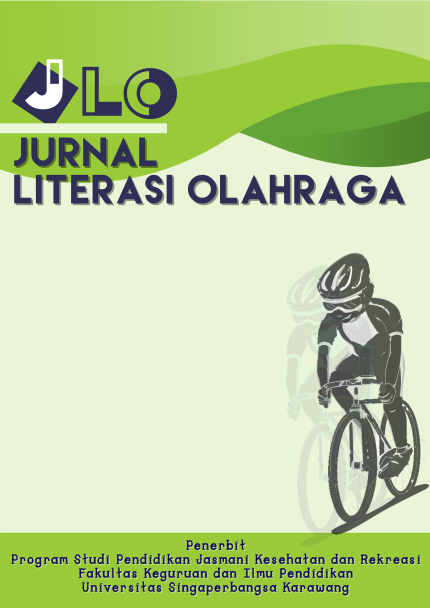Tingkat Kebugaran Jasmani Siswa Ekstrakurikuler Olahraga di SMA Negeri 1 Surade
DOI:
https://doi.org/10.35706/jlo.v2i1.3989Abstract
The purpose of this study was to determine the results of the physical fitness level of extracurricular students at SMAN 1 Surade, whether they were in the good or poor category. The subjects in this study were all members of the sports extracurricular activities at SMAN 1 Surade with 23 students as respondents. The data collection technique used in this research is descriptive quantitative research. The method used was a survey, while the data collection technique used tests, the results of the study showed that the level of physical fitness of sports extracurricular students at SMAN 1 Surade stated that they were in the "very good" category with a percentage of 0%, in the "good" category with a percentage of 0% , in the "medium" category with a percentage of 86.96%, in the "poor" category with a percentage of 13.04%, and in the "very poor" category with a percentage of 0%. Some suggestions related to this research include: 1) Schools should support all existing extracurricular activities, especially sports extracurricular activities so that they can create professional players from schools 2) For teachers or coaches, they should provide a training method that is easy for players to understand. and always motivate players when training and competing
Downloads
References
Bryantara, O. F. (2016). Faktor Yang Berhubungan Dengan Kebugaran Jasmani (Vo2Maks) Atlet Sepakbola. Jurnal Berkala Epidemiologi, 4(2), 237–249.
Komarudin. (Bandung). Psikologi Olahraga. 2015: PT Remaja Rosdakarya.
Kurniawan, F., & Mylsidayu, A. (2017). Pertumbuhan dan Perkembangan Peserta Didik. Bekasi: Samadiru Bekasi
Lestari, K. E., & Yudhanegara, M. R. (2017). Penelitian Pendidikan Matematika. Bandung: PT. Refika Aditama.
Mulyono, M. A. (2014). Buku Pintar Panduan Futsal. Banda Aceh: Laskar Aksara Media.
Mylsidayu, A. (2018). Psikologi Olahraga. Jakarta: Bumi Aksara.
Nurhayati, T. (2018). Jurnal Pendidikan Jasmani dan Olahraga. Pendidikan Jasmani Olahraga, 3(1), 122–128. https://doi.org/10.17509/jpjo.v3i1.10461
Rahayu, E. T. (2016). Strategi Pembelajaran Pendidikan Jasmani. Bandung: Alfabeta.
Rekadaya, A. (2017). Minat Mahasiswa PJKR Terhadap Mata Kuliah Olahraga Pilihan Judo.
Samsudin. (2008). Pembelajaran Pendidikan Jasmani Olahraga dan Kesehatan. Jakarta: Litera Prenada Media Group.
Setiyana, A. (2013). Persepsi Orang Tua Siswa Terhadap Mata Pelajaran Pendidikan Jasmani Olahraga dan Kesehatan Di Sekolah Dasar Negeri Harjobinangun Kecamatan Grabag Kabupaten Purworejo.
Siswanto, Tedi Purbangkara (2019), “Persepsi Siswa Terhadap Model Pembelajaran Resiprokal pada Pembelajaran Servis Bawah Bola Voli di SMPN 1 Tirtajaya” Jurnal Speed (Sport, Physical Education, Empowerment)
Sri Hapsari, (2005). Bimbingan dan Konseling SMA Untuk Kelas XII. Jakarta : PT Grasindo
Sri Wahyuni. 2010 : Pendidikan Jasmani Dan Kesehatan. Jakarta Pusat
Sugihartono, dkk, 2007. Psikologi Pendidikan. Yogyakarta: UNY Pers.
Supandi, 2011. Menyiapkan Kesuksesan Anak Anda. Jakarta : PT Gramedia pustaka utama
Thursan Hakim, (2008). Belajar Secara Evektif. Jakarta : Pustaka Pembangunan Swadana Nusantara
Uno, H.B (2016), Teori motivas dan pengukuranya, Jakarta: PT Bumi Aksara
Widy Asih Sulastri.(2011).Upaya Peningkatan Pembelajaran Passing Bawah Bolavoli Mini Pada Siswa Kelas IV SD Negeri 2 Tamanwinangun Kebumen Tahun Pelajaran 2010/2011. Skripsi. FIK
Additional Files
Published
Versions
- 2021-08-04 (2)
- 2021-08-04 (1)
How to Cite
Issue
Section
Citation Check
License
Copyright (c) 2021 Jurnal Literasi Olahraga

This work is licensed under a Creative Commons Attribution-NonCommercial 4.0 International License.





